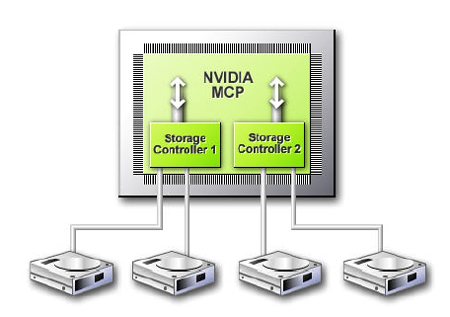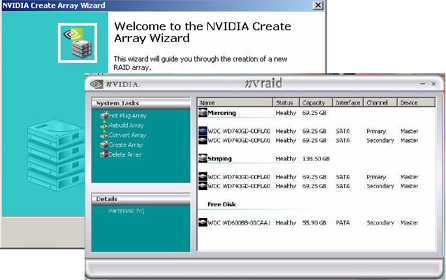 The RAID controller in the nForce
3 chipset was already one of the more innovative solutions on the market, thanks
in part to its 'flexible RAID' support. This time around, the NF4 chipset has
received a substantial new feature set.
The RAID controller in the nForce
3 chipset was already one of the more innovative solutions on the market, thanks
in part to its 'flexible RAID' support. This time around, the NF4 chipset has
received a substantial new feature set.
The new
nVidia nForce 4 supports up to 4 SATA drives, and four Parallel ATA (IDE)
drives. The serial ATA implementation now uses two separate controllers, each
supporting a pair of drives for increased performance.
All drives
can be configured into RAID 0, 1 or 0+1 arrays, regardless of which controller
they reside on; meaning you can have RAID arrays combining SATA and IDE drives,
or use IDE drives as spare fall back disks for SATA RAID arrays.
‘Hot
spares’ are supported for RAID 1 or 0+1 arrays, allowing you to have a separate
drive installed but unused and designated as a spare. If one of the disks in
your RAID array fails, the disk controller will rebuild the array on the fly
using the spare disk. To aid in swapping out defective drives, the SATA ports
support hot-swapping. All this can be done transparently within the operating
system itself.

To add to
this comprehensive list of RAID features, the chipset supports RAID ‘morphing’
where one type of RAID array can be converted into another from the operating
system. For example, you could convert a RAID 1 array to a RAID 0 stripe,
upgrade a RAID 1 mirror to RAID 0+1 (provided two extra drives were attached).
All in all,
the new nVidia NF4 chipset adds a huge amount of almost business-calibre RAID
functionality to Athlon 64 systems. Although, we’re forced to wonder what users
nVidia thinks will actually make use of all this RAID goodness.
This
would be a
good time to mention that the fourth (as yet) unreleased version of the nForce 4
chipset will apparently be a dual-Opteron based design, with 40 lanes of PCI
Express and dual PCI Express x16 video slots. It looks like we answered our own
question, as the nForce 4 chipset is undoubtedly going to be targeted towards
business users, and perhaps even servers a bit later in its active life. I doubt
it will see much application in servers, industry is usually unwelcome to new
and unproven technologies.
